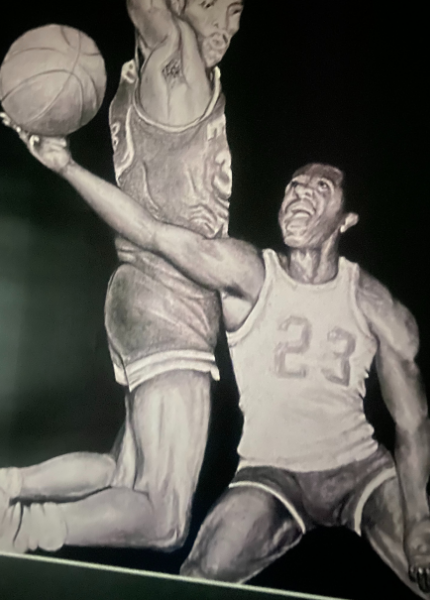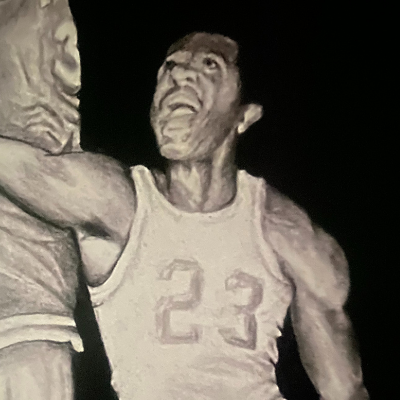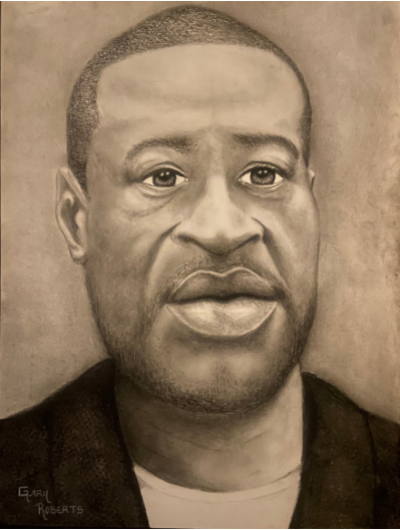Two young men, arms stretched and muscles taut, vie for control of a basketball, creating steep horizontal and vertical lines in a captured image. For David Stein, Leonville High School player #23, this moment crystallized multiple dreams.
For artist Gary Roberts, it became the subject of a charcoal drawing about good and evil.

Roberts, a lifelong resident of Nacogdoches, has made hundreds of charcoal portraits from photographs. Roberts says his mother transferred her creative talent to him at her death.
“My mother was the artist in our family. She passed away when I was 15 years old. Before that all I could draw was stick people, but after she passed, that’s when my art really took off. It’s like after she passed away that ability came to me. I just feel like my mother is living through me, through my art,” said Roberts.
Roberts was introduced to charcoal drawing at Stephen F. Austin University. To achieve his meticulously detailed photorealism, Roberts uses a variety of tools. “I use a lot of chalk, charcoal, charcoal pencils, a kneaded eraser and my finger,” he said. “I also use tissue and paper towels to get various techniques and textures to get that look.” Roberts said he is experimenting with charcoal powder and dry paintbrush application.
Using charcoal required Roberts to find new techniques, as his left-handedness created smudges. “It was a very difficult medium to draw with because it was so messy. I’m left-handed so I draw from right to left. That way it won’t be dragging across the page.”
When Roberts receives commissions, his clients send him portraits of their loved ones. In the case of the basketball players, the original image came from a 1987 newspaper clipping and a chance meeting with David Stein through Roberts’ work with those experiencing homelessness in Nacogdoches.
“The basketball players drawing belongs to a good brother of mine. There was a homeless gentleman in Nacogdoches. We were trying to find out some information,” said Roberts. The contact Roberts had was the man’s cousin, David Stein. Soon, Roberts and Stein struck a friendship.
Roberts said, “We started talking, we became close friends. He got to talking about his childhood. He had a picture from an old newspaper clipping. It was his last year of high school, his last basketball game. It was outdated and fuzzy. He sent it to me and asked could I do it?”
Stein, player #23 in the drawing, remembers meeting Roberts. “Gary was looking for [my cousin] Leonard. Leonard has a tendency to give my number as a contact. We sparked a conversation and one thing led to another. He said he was an artist. I asked him if he could draw it,” said Stein.

Roberts said working with a fuzzy, decades-old newspaper clipping was a challenge. “I blew it up as big as I could so I could really see the details and I tweaked it.”
For Stein, the newspaper clipping and Roberts’ charcoal rendering became a metaphor about his life and purpose.
Stein said the original photo was made during the Port Barre High School Class B regional playoffs in Louisiana in 1987. At the time, Stein was a senior at Leonville High School in a town north of Lafayette.
Stein’s basketball hobby began as a kid living with his five siblings, two of whom were disabled. “There were six of us: my oldest sister Sandra, my brother Paul, called Anthony, was handicapped; then me, then Tyrone, then Tim, who was also handicapped and baby sister Lecretia.”
Stein says from an early age, he was troubled by the way his brothers were treated.
“It was very challenging. Other kids were laughing when they would fall. I would want to fight because ‘don’t laugh at my brother.’ I kind of felt guilty with people staring at him. But Tyrone, it wouldn’t bother him. ‘How can you just be bold and not worry about when people are staring or laughing?’ And I learned from watching him. I became bold. ‘This is my brother, I love him and I don’t care what anybody thinks.’”
Later, a makeshift basketball goal gave Stein a way to channel his energies.
“We were looking for things to do to not be bored. We went to the gully, cut down a tree, dug a pole with a post hole digger and a shovel and we put it in the hole and after that, we needed a backboard. We found ¾” plywood for the backboard and cut that. Somehow we got a rim. It was broken so I took it to school and asked a friend to weld it. It was all crooked,” said Stein.
Even with its imperfections, the homemade basketball goal gave Stein a place to hone his skills. “The post wasn’t straight, the rim was crooked with no net. But it helped me to focus on how to shoot better. Every day we would shoot baskets until well into the night, playing on the dirt,” he said.
Stein graduated from a dirt lot to Leonville High School’s hardwood gym floor. “As I was playing I would think, ‘Why can’t I be in the paper? The same guys are always in the paper. I wonder why I can’t do that.’”
In the last game of his senior year, Stein played his best-ever game, scoring 16 points. His feat and his photo were put in print in the local newspaper. Stein says that decades later, he had an epiphany about the moment.

“Decades later, God rewound the tape and showed me some things. He said, ‘David, let me take you back to where I was working and you had no idea.’ That photo came to mind. ‘Look, you made the paper. Look at the date, look at the score and the points you made. That was your last game. I did that for you.’”
For Stein, the revelation was nothing short of life-changing.
“The significance [of that newspaper clipping is] that God has had his eye on me, caring for me throughout my life. I see things in my life that have just unfolded.
“My two brothers, I would ask ‘Why can’t they walk?’ God said, ‘They are in your life for you. You are in your life for them.’”
As Roberts worked on the charcoal drawing from the newspaper photo, he developed his own interpretation of the image.

“When I was drawing that picture, I saw good and evil. David is the one that had the ball and the one that was hovering above him. To me, he was like the enemy. He was trying to get around him, trying to score. And then the strain on his face, the strain in his muscle,” said Roberts.
Roberts said that photo realism is his goal. “I want it to look better than a photo,” he said. Nonetheless, he is not averse to changing minor details to enhance the drawing. “There were some little objects I could barely see in [the photo] in the gym that were behind him. I just wanted to block all that out so there would be those two images with the goal post,” said Roberts.

When asked what stands out to Roberts in his drawing, he said, “The use of black. It was a white piece of paper and then blacked all the way out. I outlined the two images and blacked the rest out,” he said.
“I love working with the shadows on the face and the eyes. I love the eyes because I feel the eyes are literally the gateway to the soul. I want them to be to the point where they actually follow you around in the room. No matter where your vantage point is, I want that portrait to be looking at you.”

Roberts names several artists who have influenced him including Ernie Barnes of “Good Times” fame, 17th century Dutch painter Rembrandt and the late East Texas artist Dwight Gibson.
In addition to charcoal portraits, Roberts is director of community mobilization at Brown Family Health Center in Nacogdoches. He works with residents including those who are HIV-infected, sex workers and those without housing.
“I serve God and in serving God, I serve humanity,” said Roberts. “I’ve had to tell 19 people that they were HIV positive, and that alone is something that changes you.”
Love what you're seeing in our posts? Help power our local, nonprofit journalism platform — from in-depth reads, to freelance training, to COVID Stories videos, to intimate portraits of East Texans through storytelling.
Our readers have told us they want to better understand this place we all call home, from Tyler's north-south divide to our city's changing demographics. What systemic issues need attention? What are are greatest concerns and hopes? What matters most to Tylerites and East Texans?
Help us create more informed, more connected, more engaged Tyler. Help us continue providing no paywall, free access posts. Become a member today. Your $15/month contribution drives our work.







